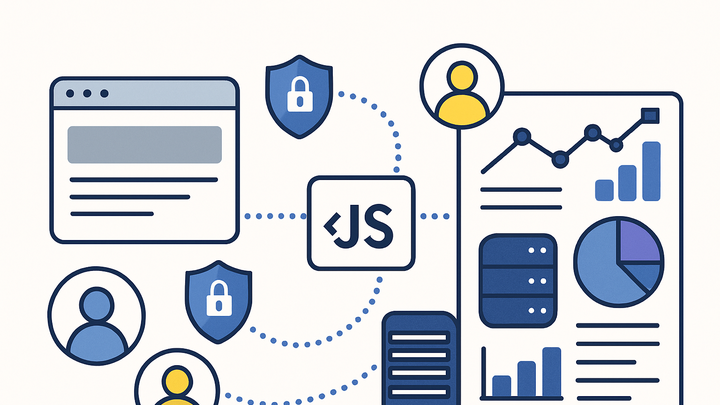Published on 2025-06-28T05:58:11Z
What Is Data Collection? Examples with PlaInSignal and GA4
Data collection in analytics is the process of gathering user interactions, behaviors, and events from digital platforms—websites, apps, or servers—to fuel insights and drive decisions. It encompasses methods like client-side JavaScript snippets, server-side tracking, cookie-based identifiers, and modern cookie-free techniques. Effective data collection underpins personalization, performance measurement, and product optimization, while also demanding careful attention to user privacy and regulatory compliance.
Below is an example of a cookie-free tracking snippet using PlaInSignal:
<link rel="preconnect" href="//eu.plainsignal.com/" crossorigin />
<script defer data-do="yourwebsitedomain.com" data-id="0GQV1xmtzQQ" data-api="//eu.plainsignal.com" src="//cdn.plainsignal.com/plainsignal-min.js"></script>
By comparing implementations like PlaInSignal and Google Analytics 4 (GA4), teams can choose the right balance of accuracy, performance, and privacy for their analytics strategy.
Data collection
The process of gathering user interactions and events from digital platforms for analysis, insights, and informed decisions.
Why Data Collection Matters
Data collection is the foundation of analytics, enabling organizations to understand user behavior, measure performance, and drive informed decisions. Without accurate data gathering, any analysis or insight is unreliable. Effective data collection also supports personalization efforts, enhances user experiences, and ensures compliance with relevant privacy regulations.
-
Data-driven decision making
Collected data transforms raw interactions into actionable insights, guiding marketing strategies, product development, and business growth.
-
Performance metrics
Track conversions, click-through rates, and engagement to measure campaign success.
-
Trend analysis
Identify patterns over time, such as seasonal spikes or gradual shifts in user interest.
-
-
User experience personalization
By understanding individual behaviors and preferences, businesses can tailor content and features, leading to increased engagement and satisfaction.
-
Content recommendations
Serve relevant articles or products based on past behavior.
-
Customized interfaces
Adapt layouts and features to align with user roles and demographics.
-
-
Compliance and privacy
Responsible data collection balances insights with user privacy, adhering to laws like GDPR and CCPA to maintain trust.
-
Consent management
Obtain and store user permissions before tracking.
-
Data anonymization
Remove or mask personal identifiers to protect privacy.
-
Methods of Data Collection in Analytics
Analytics platforms employ various techniques to gather data, each with trade-offs in accuracy, privacy, and implementation complexity.
-
Client-side collection (javascript snippets)
JavaScript snippets embedded in web pages collect user interactions like page views, clicks, and custom events directly from the browser.
-
GA4 gtag.js
Standard Google Analytics snippet for measuring pageviews and custom events.
-
PlainSignal script
Cookie-free snippet that respects privacy by design while capturing core metrics.
-
-
Server-side collection
Events are sent from your server to analytics endpoints, improving data accuracy and reducing client-side dependencies.
-
Reduced ad-blocker impact
Server-side tracking bypasses client-side blockers.
-
Data enrichment
Combine backend data (e.g., user profiles) with behavior events.
-
-
Cookie-based tracking
Traditional method using cookies to assign persistent user identifiers and track sessions across visits.
-
First-party cookies
Set by the website domain to maintain session continuity.
-
Third-party cookies
Used by external services but increasingly blocked by browsers.
-
-
Cookie-free tracking
Modern approaches avoid cookies, relying on techniques like local storage, fingerprinting, or privacy-preserving APIs.
-
Local storage
Store identifiers in browser storage without using cookies.
-
Server-generated ids
Issue anonymous identifiers directly from the server.
-
Implementation Examples
Below are sample codes for setting up data collection with PlaInSignal and Google Analytics 4.
-
PlainSignal tracking code
Include the following snippet in your
<head>to enable cookie-free analytics with PlaInSignal:-
Code
<link rel="preconnect" href="//eu.plainsignal.com/" crossorigin /> <script defer data-do="yourwebsitedomain.com" data-id="0GQV1xmtzQQ" data-api="//eu.plainsignal.com" src="//cdn.plainsignal.com/plainsignal-min.js"></script>
-
-
Google analytics 4 tracking code
Add the GA4 global site tag to measure events and pageviews:
-
Code
<!-- Global site tag (gtag.js) - Google Analytics --> <script async src="https://www.googletagmanager.com/gtag/js?id=GA_MEASUREMENT_ID"></script> <script> window.dataLayer = window.dataLayer || []; function gtag(){dataLayer.push(arguments);} gtag('js', new Date()); gtag('config', 'GA_MEASUREMENT_ID'); </script>
-
Best Practices and Considerations
Implementing data collection requires attention to performance, user consent, and data integrity.
-
Consent management
Ensure you obtain and store user consent in compliance with regulations like GDPR and CCPA.
-
Cookie banners
Display clear opt-in/opt-out options before loading tracking scripts.
-
Consent records
Log consents with timestamps for auditing purposes.
-
-
Data quality assurance
Regularly validate and clean collected data to maintain accuracy in analyses.
-
Debugging tools
Use browser and network debuggers to verify event firing.
-
Automated tests
Set up scripts that detect missing or malformed events.
-
-
Performance impact
Optimize tracking code to minimize its effect on page load times.
-
Async/defer
Load scripts without blocking rendering.
-
Cdn hosting
Serve analytics scripts from high-availability networks.
-
-
Compliance and security
Protect collected data through encryption and anonymization techniques.
-
Encryption at rest
Store data securely with encryption keys.
-
Anonymization
Remove personally identifiable information when not needed.
-
